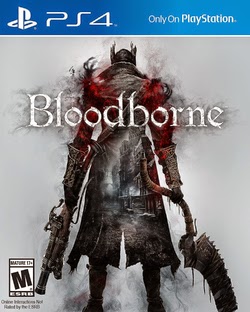Bloodborne - First Impressions
Admittedly,
I was never a big fan of the “Souls” series by From Software. I never had a
PlayStation 3, so I was never able to try Demon’s Souls. I did try getting into
Dark Souls on Xbox 360 because I had heard so much about the series and had a
friend who was a huge fan talk it up to me. But after playing for several
hours, I wasn’t impressed. The ambiguity and intentional obscurity in the
design and presentation, mixed with the immediate and steep learning curve
really turned me off and I barely made a dent in Dark Souls. When Dark Souls 2
came out, I contemplated giving the series another chance but decided against
it.
Considering
all that, I was surprised when I found myself so intrigued by From Software’s
latest title, “Bloodborne,” a PlayStation 4 exclusive. Not only that but I was
even more surprised when I found myself really enjoying Bloodborne.
Set
in the strange, forgotten town of Yharnham, you take on the role of a hunter
seeking an ancient medicine rumored to be held somewhere in the cursed city.
Incorporating an exaggerated gothic style, Bloodborne is like a horror movie
come to life as Yharnham is inhabited by all manner of outlandish and vicious
beasts.
If
you’ve played any of the Souls games before, you’ll have a good headstart on
how Bloodborne works, though there are some key differences. Careful and
considered play is your best course of action since the lowest level enemy can
kill you in a moment’s notice and the towering boss monsters can dispatch you
even quicker. Unlike the Souls games, there is no blocking in Bloodborne, only
dodging and evading. Due to the lack of blocking, the stamina meter is much
more quick to recharge in Bloodborne.
There
is also another big difference in the combat between the Souls games and
Bloodborne. A new mechanic called the “regain system” allows you to regenerate
a portion of life lost but it is a risky proposition to make the most of
regain. After you’ve taken damage, your health bar drains with a white mark
noting how much health you have left but to the right of the mark, a lighter
shade of red remains for a few seconds. If you can deal damage while this
portion of the bar remains, you will regenerate some lost health. Obviously,
therein lies the risk – attacking the creature that just damaged you to regain
some lost health could result in even more damage or death. It’s a risk but the
quick combat in Bloodborne makes it a possibility.
Also
like the Souls games, you earn “blood echoes” which can be spent on purchasing
gear or leveling up your character. Though if you die, you lose all that earned
XP creating a risk-reward dilemma between grinding for blood echoes and risking
losing them all.
Overall,
I’ve been having way more fun with Bloodborne than any of the Souls games and I
think it’s because Bloodborne isn’t as intentionally obscure and confusing as
the Souls games, making it more accessible to people who don’t want to spend
time experimenting with every item or stat trying to figure out what it does or
affects. Similarly, while the combat and difficulty are intense, I feel like
Bloodborne has more in common with hack-and-slash games than the Souls series.
Now, that isn’t to say that Bloodborne is hack-and-slash because it most
definitely is not. But the emphasis on staying quick while dealing damage
reminds me more of standard action/adventure games than the time I spent
playing Dark Souls. Also, the atmosphere and aesthetics of Bloodborne are much,
much cooler (in my opinion) than the Souls games. The easiest way I can explain
it is if the Souls games are fantasy movies, Bloodborne is a horror film.
I’m
planning on doing a full review for Bloodborne but I want to get a little
deeper into it before I do but that could take some time. (I’m several hours in
but only just recently beat the Cleric Beast and found the second boss. Right
now I’m trying to grind for more XP to level up before trying to fight the next
boss again while looking through Central Yharnham for any secret areas I surely
missed.)
If
you were a fan of From Software’s earlier games or are looking for a game that
offers a serious challenge, definitely look into Bloodborne.
Labels: Bloodborne, Dark Souls, Demon's Souls, From Software, PlayStation 4, PS4, Yharnham
 RSS Feeds
RSS Feeds





